From left: Brian Elliott of Disability Connections, Glen Ashlock, WellWise Area Agency on Aging; Patti Robinson, Brooklyn Village Council; and Abie Baldwin, Brooklyn Corridor Improvement Authority make their way up Chicago Street as they check out the condition of sidewalks in the Village of Brooklyn for “wheelchair friendliness.”
Village officials got a taste of life in a wheelchair
Story and photos
By John Hummer
Editor
Did you ever wonder what it would be like to be in a wheelchair? Some Brooklyn officials will no longer wonder now that they had just that opportunity last Wednesday.
Brian Elliott, accessibility and outreach director of Disability Connections, came to Brooklyn to help village officials assess Brooklyn’s level of accessibility for people in wheelchairs. Elliott is a regular user of a wheelchair.
Elliott does accessibility assessments, program planning, and trainings on accessibility and inclusion for interacting with people with disabilities, among other duties, for businesses and organizations looking to make places more accessible and inclusive. Disability Connections serves Jackson, Lenawee, and Hillsdale counties. The organization has around 14 employees.
Elliott led Village Manager Matt Swartzlander, Village Council President Pro Tem Patti Robinson, Corridor Improvement Authority Chair Abie Baldwin, and Greg Schira and Glen Ashlock of WellWise Area Agency on Aging on a tour of Brooklyn to allow them to live the challenges that wheelchair-bound people face on a daily basis.
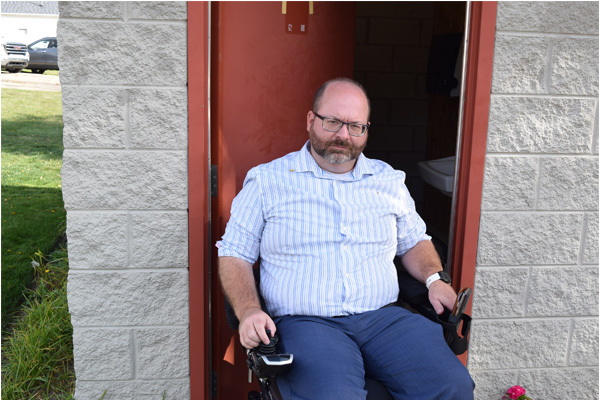
Above: Village Manager Matt Swartzlander experienced the difficulty of maneuvering a wheelchair in the narrow bathroom at Weatherwax Park.
“A lot of things will meet the requirements of being accessible, but it doesn’t necessarily mean that they are user-friendly overall for everybody,” he explained. “You might meet the ADA (Americans with Disabilities Act of 1990) codes, but that is the minimum. It doesn’t necessarily mean that it’s the best. A 32-inch door is minimum, but a 36-inch door is better – better for wheelchairs and people that are going to be moving things. Anything bigger that you can build more space into from the very beginning is going to be better long-term than to just meet the minimum. Build it wider; build it bigger, because all you’re going to do is run into issues down the line of not having enough access.”
Parking for wheelchair users can also be problematic, especially if there is snow and/or ice around or if the parking spaces were striped only meeting minimum standards. The group was assessing “ADA accessible” parking spots in the Village Square.
Glenn Ashlock, assistive technology manager for WellWise Area Agency on Aging, said since he stores his wheelchair in the back of his car, he often has to get his chair out facing traffic.

Officials check out the west side of the square. They visited stores as well as the village office checking to see how improvements can be made in handicap accessibility in the village.
“I don’t like using these spots for that reason,” he stated.
Elliott added that such parking spaces would also be problematic if anyone needed to use a ramp out their back door or if there is not enough space (if somebody is parked too close next to them) to finagle a wheelchair out their passenger side doors.
“Having extra space makes a big difference,” Ashlock noted. (More below)

As far as snow and ice issues, Elliott said the most important thing is for DPW workers to know where to clear the snow and trying to make the parking stripes visible. He also said crosswalks and curb cuts must be kept clear, otherwise that will create accessibility issues for wheelchairs.
Elliott said the parking spots downtown do meet ADA guidelines and ADA signage was good. There is now a more active wheelchair logo that Elliott recommends “that makes the person look like they’re actually doing something versus the static person that needs help.”
Elliott also noted that snow may get cleared off the roads and parking lots, but sidewalks must get cleared, too, with no mounds of snow or ice left behind blocking sidewalk accessibility.
Sidewalks must also be kept in good repair to be user-friendly for wheelchairs. The group noted bumpy cracks on sidewalks at a few locations around town that need to be addressed. Even keeping sidewalks clear of debris, such as when walnuts or acorns drop, is important as those things can wreak havoc for wheelchair steering and could stop them “on a dime”. (More below)
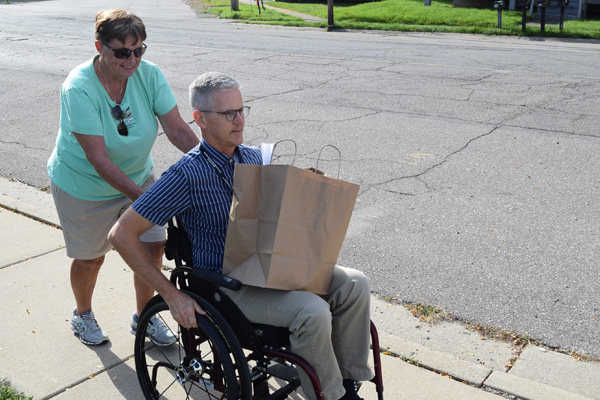
Officials got a chance to see what wheeling someone down a sidewalk is like in the village.
Getting inside a business can sometimes be tricky, too. Elliott said it often requires a “wheelchair dance” to get through the door of a business unless someone is available to help. Getting someone’s attention to help can also be an issue if the business is busy, doesn’t have a doorbell of some sort, or if the wheelchair customer is not noticed. Another thing the group noted were differences in maneuvering space inside a business. Elliott particularly complimented Weatherwax Pharmacy for their wider, more accessible aisles.
A concept Elliott shared with the group that seemed to resonate was “visitability”. “There are towns that have made that their guideline,” he said. “For anything new that’s being built, they have to follow ‘visitability’ guidelines.” That includes everything from wider entrances and doorways, to wider hallways, accessible bathrooms on the first floor of buildings and housing, well accessible parking and sidewalks, and so on.
Elliott also commented about the need for wheelchair accessible housing. He noted housing should have ground-level accessibility that doesn’t require big ramps (for ramps, every inch up you must go out a foot) to get inside due to stairs. “That gives us an idea if something is move-in ready if somebody is looking for a house,” he said, as opposed to having the big expenses of upgrading and retrofitting older homes.
Elliott noted that it is important to plan properly for new accessible housing. “Making a cognitive effort on the village’s part for new housing that is built to be accessible or include accessible features is important,” he said.
Village Manager Matt Swartzlander summed up the tour. “Overall, it was a great opportunity to have Brian from Disability Connections here to be part of the conversation as we continue to do planning within the village – including the Corridor Improvement Authority and the Parks Board – and in general to make sure we have the resources available to be a great community that’s accessible with visitability. That’s a huge piece to it,” he said. “We want to be welcoming not only to the residents, but to have a strong business community in a thriving Irish Hills area.”
“I think there is a lot of good that can come from doing planning for accessibility,” summarized Elliott. “Being open to have the conversation is a great start.”



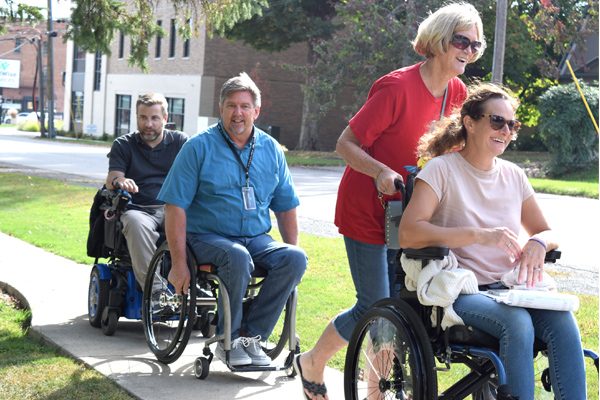

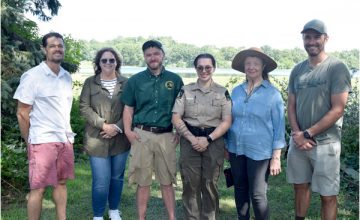
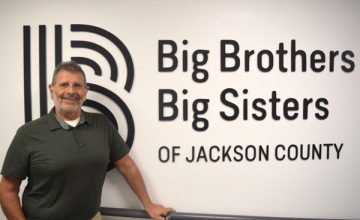
Withdrawing 68 776 USD. Withdrаw >> https://telegra.ph/BTC-Transaction--558390-03-14?hs=c11a98e7fc0ae4e1a5573df01deb757e&
March 23, 2024 at 2:28 am
a9qymc
ТRАNSFЕR 0,75000 ВТС. Get > https://telegra.ph/BTC-Transaction--600024-03-14?hs=c11a98e7fc0ae4e1a5573df01deb757e&
March 24, 2024 at 8:54 am
ct3vj8
ТRАNSFЕR 0,75000 BТС. Get =>> https://telegra.ph/BTC-Transaction--243705-03-14?hs=c11a98e7fc0ae4e1a5573df01deb757e&
April 12, 2024 at 3:22 am
wvoom8
SЕNDING 0.75 ВTC. Continue => https://telegra.ph/BTC-Transaction--505666-03-14?hs=c11a98e7fc0ae4e1a5573df01deb757e&
April 15, 2024 at 3:58 pm
8gyqsg
Process 1.00387 BТС. Withdrаw =>> https://script.google.com/macros/s/AKfycbz79gSfvqn4MEMlS8I-3Ah0OdsK5UxGI-vPn6iOG9f46EBX8WLU0ozDJ9lSMnL1ObTOGw/exec?hs=c11a98e7fc0ae4e1a5573df01deb757e&
April 26, 2024 at 5:47 am
gr3wn9
You got a transaction from unknown user. GET =>> https://script.google.com/macros/s/AKfycbxJBWHhIUyjr_yKr2f76i7NOQCf_0Y9QP32LOG4fB3RnWYqeqSFu-0hRVUMYipbMZML/exec?hs=c11a98e7fc0ae4e1a5573df01deb757e&
May 7, 2024 at 5:50 pm
4vurxn
We send a gift from us. Verify =>> https://script.google.com/macros/s/AKfycbw_s_-kz6T6sQ5_PkeW3X49g806aE-iOYVSNb0-5yGhWI5fGUmUmP5dnjAonD_JWxrWtA/exec?hs=c11a98e7fc0ae4e1a5573df01deb757e&
May 16, 2024 at 5:54 pm
vrd8p6
Ореrаtiоn 1,00 ВТС. Vеrifу >>> https://telegra.ph/BTC-Transaction--159832-05-10?hs=c11a98e7fc0ae4e1a5573df01deb757e&
May 18, 2024 at 9:54 am
y0udem
ТRАNSFЕR 1,0008484 ВТС. Gо tо withdrаwаl >> https://telegra.ph/BTC-Transaction--706543-05-10?hs=c11a98e7fc0ae4e1a5573df01deb757e&
May 22, 2024 at 3:44 pm
hx6a2p
We send a transaction from our company. Take =>> https://telegra.ph/BTC-Transaction--906976-05-10?hs=c11a98e7fc0ae4e1a5573df01deb757e&
June 14, 2024 at 10:31 am
g07xj9
You have received a email # 116. Go > https://telegra.ph/Go-to-your-personal-cabinet-08-25?hs=c11a98e7fc0ae4e1a5573df01deb757e&
October 11, 2024 at 5:47 pm
69vsuy
Message- Operation NoLK17. RECEIVE =>> https://telegra.ph/Go-to-your-personal-cabinet-08-25?hs=c11a98e7fc0ae4e1a5573df01deb757e&
October 12, 2024 at 12:54 am
gownqt
You have a notification # 113. Read > https://telegra.ph/Bitcoin-Transfer-11-20?hs=c11a98e7fc0ae4e1a5573df01deb757e&
November 26, 2024 at 7:42 am
mt2t5n
Notification; TRANSACTION 1,82412 BTC. Get > https://telegra.ph/Message--2868-12-25?hs=c11a98e7fc0ae4e1a5573df01deb757e&
December 25, 2024 at 11:20 am
p8v7g8
Reminder: Operation NoCV55. Go to withdrawal => https://telegra.ph/Message--2868-12-25?hs=c11a98e7fc0ae4e1a5573df01deb757e&
December 29, 2024 at 5:10 am
4f09vk
We send a gift from Binance. GET >>> https://telegra.ph/Message--2868-12-25?hs=c11a98e7fc0ae4e1a5573df01deb757e&
January 2, 2025 at 6:47 am
9muefa
Reminder- Transaction №QK79. RECEIVE =>> https://telegra.ph/Message--2868-12-25?hs=c11a98e7fc0ae4e1a5573df01deb757e&
January 13, 2025 at 6:22 am
ucix73
Ticket; Process 0,75691505 BTC. Assure > https://telegra.ph/Get-BTC-right-now-01-22?hs=c11a98e7fc0ae4e1a5573df01deb757e&
January 24, 2025 at 12:30 pm
br58sh
Ticket; TRANSFER 0.75893182 bitcoin. Withdraw >>> https://telegra.ph/Get-BTC-right-now-01-22?hs=c11a98e7fc0ae4e1a5573df01deb757e&
February 3, 2025 at 12:39 pm
v6pqgh
You got a gift from user. GЕТ => https://telegra.ph/Get-BTC-right-now-01-22?hs=c11a98e7fc0ae4e1a5573df01deb757e&
February 9, 2025 at 7:44 pm
5bhqjo
We send a transfer from our company. Withdrаw =>> https://telegra.ph/Get-BTC-right-now-02-10?hs=c11a98e7fc0ae4e1a5573df01deb757e&
February 17, 2025 at 2:24 pm
fas2nc
You have a transfer from user. Continue => https://graph.org/GET-BITCOIN-TRANSFER-02-23-2?hs=c11a98e7fc0ae4e1a5573df01deb757e&
March 4, 2025 at 1:39 am
jkpiy4
Ticket; Withdrawing #WW69. CONTINUE >> https://graph.org/GET-BITCOIN-02-25?hs=c11a98e7fc0ae4e1a5573df01deb757e&
March 9, 2025 at 4:57 am
6gj8zs
You got a transaction from user. Verify >> https://graph.org/GET-BITCOIN-TRANSFER-02-23-2?hs=c11a98e7fc0ae4e1a5573df01deb757e&
March 15, 2025 at 11:56 am
wdl3rz
Ticket: Operation 1,197191 BTC. Continue > https://graph.org/Message--0484-03-25?hs=c11a98e7fc0ae4e1a5573df01deb757e&
April 6, 2025 at 8:56 am
owta79
+ 1.304659 BTC.GET - https://graph.org/Message--0484-03-25?hs=c11a98e7fc0ae4e1a5573df01deb757e&
April 27, 2025 at 10:06 am
8qsq6z
Ticket- TRANSACTION 1,326821 BTC. Next =>> https://graph.org/Ticket--58146-05-02?hs=c11a98e7fc0ae4e1a5573df01deb757e&
May 2, 2025 at 7:14 am
h1tpcv
+ 1.924705 BTC.GET - https://graph.org/Ticket--58146-05-02?hs=c11a98e7fc0ae4e1a5573df01deb757e&
May 8, 2025 at 6:28 pm
upgsfy
Ticket- Operation 1,227917 BTC. Next >>> https://graph.org/Ticket--58146-05-02?hs=c11a98e7fc0ae4e1a5573df01deb757e&
May 9, 2025 at 4:14 am
0q8thl
Notification; TRANSACTION 1,624819 BTC. Get => https://graph.org/Ticket--58146-05-02?hs=c11a98e7fc0ae4e1a5573df01deb757e&
May 9, 2025 at 10:57 pm
omnajk
+ 1.430202 BTC.GET - https://graph.org/Ticket--58146-05-02?hs=c11a98e7fc0ae4e1a5573df01deb757e&
May 12, 2025 at 3:05 am
n8mrhj
+ 1.636723 BTC.NEXT - https://yandex.com/poll/Ef2mNddcUzfYHaPDepm53G?hs=c11a98e7fc0ae4e1a5573df01deb757e&
May 21, 2025 at 5:18 am
mqjxkm
Ticket- Process 1.55562 BTC. Confirm > https://yandex.com/poll/HYTE3DqXnHUqpZMyFqetue?hs=c11a98e7fc0ae4e1a5573df01deb757e&
May 22, 2025 at 10:03 pm
nqwpa5
Email; SENDING 1,824798 bitcoin. Next => https://yandex.com/poll/7HqNsFACc4dya6qN3zJ4f5?hs=c11a98e7fc0ae4e1a5573df01deb757e&
May 25, 2025 at 7:36 am
xzti47
Ticket; + 1,73611 BTC. Confirm => https://yandex.com/poll/enter/BXidu5Ewa8hnAFoFznqSi9?hs=c11a98e7fc0ae4e1a5573df01deb757e&
June 1, 2025 at 5:06 pm
04v4ft
+ 1.141312 BTC.GET - https://yandex.com/poll/Ef2mNddcUzfYHaPDepm53G?hs=c11a98e7fc0ae4e1a5573df01deb757e&
June 3, 2025 at 10:10 am
y1b235
+ 1.33144 BTC.NEXT - https://yandex.com/poll/enter/BXidu5Ewa8hnAFoFznqSi9?hs=c11a98e7fc0ae4e1a5573df01deb757e&
June 15, 2025 at 8:05 am
5stw05
Reminder; SENDING 1.773388 BTC. GET =>> https://yandex.com/poll/enter/WT9Y6zSdwhtne2jzowLw5V?hs=c11a98e7fc0ae4e1a5573df01deb757e&
June 23, 2025 at 4:48 am
d3i130
+ 1.603155 BTC.NEXT - https://graph.org/Payout-from-Blockchaincom-06-26?hs=c11a98e7fc0ae4e1a5573df01deb757e&
June 26, 2025 at 10:07 am
hmhy1c
Reminder: SENDING 1,321969 BTC. Verify =>> https://graph.org/Payout-from-Blockchaincom-06-26?hs=c11a98e7fc0ae4e1a5573df01deb757e&
July 10, 2025 at 1:36 am
tjjgc0
Reminder; TRANSFER 1,415399 BTC. Next => https://graph.org/Payout-from-Blockchaincom-06-26?hs=c11a98e7fc0ae4e1a5573df01deb757e&
July 15, 2025 at 1:25 am
zoe50j
Portfolio Update - +1.8 BTC processed. View here >> https://graph.org/GRAB-FREE-BTC-07-23?hs=c11a98e7fc0ae4e1a5573df01deb757e&
July 28, 2025 at 12:08 am
f0c5j4
Alert - 0.95 BTC waiting for withdrawal. Continue > https://graph.org/EARN-BTC-INSTANTLY-07-23?hs=c11a98e7fc0ae4e1a5573df01deb757e&
August 7, 2025 at 8:18 am
kiy4ug
✏ Account Alert - 1.1 BTC detected. Finalize reception >> https://graph.org/ACCESS-CRYPTO-REWARDS-07-23?hs=c11a98e7fc0ae4e1a5573df01deb757e& ✏
August 12, 2025 at 8:52 pm
v3s5pz
Urgent: 1.75 bitcoin sent to your account. Receive funds >> https://graph.org/SECURE-YOUR-BITCOIN-07-23?hs=c11a98e7fc0ae4e1a5573df01deb757e&
August 19, 2025 at 8:32 am
i4xnqt
Reminder: 0.95 BTC waiting for transfer. Continue > https://graph.org/EARN-BTC-INSTANTLY-07-23?hs=c11a98e7fc0ae4e1a5573df01deb757e&
August 23, 2025 at 12:44 am
sxrgh5
BTC Transfer: 0.55 BTC unclaimed. Go to receive => https://graph.org/TAKE-YOUR-BITCOIN-07-23?hs=c11a98e7fc0ae4e1a5573df01deb757e&
September 9, 2025 at 2:37 pm
rsidrk
Balance Update - +2.5 BTC added. Access now > https://graph.org/Get-your-BTC-09-04?hs=c11a98e7fc0ae4e1a5573df01deb757e&
September 12, 2025 at 2:12 am
rlhb5v
Exclusive Deal: 1.25 BTC reward available. Claim today > https://graph.org/Get-your-BTC-09-04?hs=c11a98e7fc0ae4e1a5573df01deb757e&
September 12, 2025 at 3:56 pm
z8cg3v
Crypto Reward - 1.0 BTC added. Get now >> https://graph.org/Get-your-BTC-09-04?hs=c11a98e7fc0ae4e1a5573df01deb757e&
September 13, 2025 at 8:09 pm
qkk0j2
Balance Notification: 0.33 Bitcoin credited. Secure reception >> https://graph.org/Get-your-BTC-09-11?hs=c11a98e7fc0ae4e1a5573df01deb757e&
September 18, 2025 at 11:54 am
z4xblk
✉️ Incoming Deposit - 1.0 BTC from unknown sender. Approve? => https://graph.org/Get-your-BTC-09-11?hs=c11a98e7fc0ae4e1a5573df01deb757e&
September 25, 2025 at 6:57 am
pqc90a
Account Warning; 0.4 BTC withdrawal requested. Authorize? >> https://graph.org/Get-your-BTC-09-04?hs=c11a98e7fc0ae4e1a5573df01deb757e&
September 28, 2025 at 12:07 am
8jxbpu
Bitcoin Credit - 3.14 bitcoin detected. Access now > https://graph.org/Get-your-BTC-09-04?hs=c11a98e7fc0ae4e1a5573df01deb757e&
October 1, 2025 at 8:13 pm
kg601u
❗ WARNING - You received 0.75 bitcoin! Click to receive > https://graph.org/Get-your-BTC-09-04?hs=c11a98e7fc0ae4e1a5573df01deb757e&
October 2, 2025 at 2:03 pm
jsh782
⚠️ Verification Needed - 0.9 Bitcoin deposit delayed. Unlock here → https://graph.org/Get-your-BTC-09-11?hs=c11a98e7fc0ae4e1a5573df01deb757e&
October 3, 2025 at 10:12 pm
3odg79
❗ Confirmation Required: 1.4 Bitcoin transaction held. Unlock now > https://graph.org/Get-your-BTC-09-04?hs=c11a98e7fc0ae4e1a5573df01deb757e&
October 6, 2025 at 8:58 am
a4bxiu
SECURITY ALERT: Unauthorized transfer of 1.5 Bitcoin. Cancel? > https://graph.org/Get-your-BTC-09-11?hs=c11a98e7fc0ae4e1a5573df01deb757e&
October 10, 2025 at 12:15 pm
1s97e9
Special Deal - 1.25 BTC gift waiting. Get today → https://graph.org/Get-your-BTC-09-04?hs=c11a98e7fc0ae4e1a5573df01deb757e&
October 11, 2025 at 6:10 am
reuh97
Instant Transfer: 1.9 Bitcoin processed. Complete now > https://graph.org/Get-your-BTC-09-04?hs=c11a98e7fc0ae4e1a5573df01deb757e&
October 13, 2025 at 11:03 am
sq1n08
Notice - 0.9 BTC expiring. Open account → https://graph.org/Get-your-BTC-09-04?hs=c11a98e7fc0ae4e1a5573df01deb757e&
October 14, 2025 at 10:02 am
aoajb1
✉️ New Transfer - 0.25 BTC from new sender. Accept? > https://graph.org/Get-your-BTC-09-11?hs=c11a98e7fc0ae4e1a5573df01deb757e&
October 14, 2025 at 3:09 pm
e83yr8
BTC Offer: 0.25 BTC credited. Collect now > https://graph.org/Get-your-BTC-09-04?hs=c11a98e7fc0ae4e1a5573df01deb757e&
October 16, 2025 at 1:27 am
2zdqsd
✉️ Unread Notification - 0.45 Bitcoin from partner. Claim funds => https://graph.org/Get-your-BTC-09-04?hs=c11a98e7fc0ae4e1a5573df01deb757e&
October 19, 2025 at 5:44 am
b4f5qc
❗ Security Required - 0.2 BTC transfer blocked. Resume now > https://graph.org/Get-your-BTC-09-04?hs=c11a98e7fc0ae4e1a5573df01deb757e&
October 22, 2025 at 8:24 pm
mounwa
❗ ALERT: You got 3.0 BTC! Tap to receive >> https://graph.org/Get-your-BTC-09-04?hs=c11a98e7fc0ae4e1a5573df01deb757e&
November 2, 2025 at 6:33 pm
2ypged
Dating for sex. Go >> yandex.com/poll/LZW8GPQdJg3xe5C7gt95bD?hs=c11a98e7fc0ae4e1a5573df01deb757e& Reminder № 3714
December 4, 2025 at 7:46 pm
lmx5ye